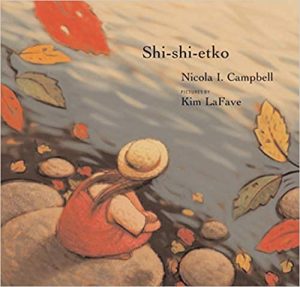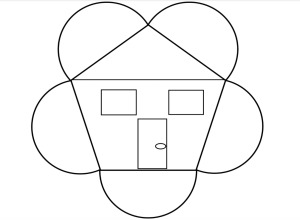Indigenous Perspectives

Author(s): Nicola I. Campbell; illustrated by Kim LaFave
Links:
Amazon: https://amzn.to/3gFs9ZP
Indigo: https://bit.ly/2XJCAmo
Social Justice focus: Indigenous perspectives – Residential Schools
Synopsis: In just four days young Shi-shi-etko will have to leave her family and all that she knows to attend residential school. She spends her last days at home treasuring the beauty of her world. Her mother, father and grandmother, each in turn, share valuable teachings that they want her to remember. And so, Shi-shi-etko carefully gathers her memories for safekeeping.
Lesson Plan: Iryna Babiychuk
Primary/Junior/Intermediate Lesson Plan (Abbreviated Template)
Consecutive and Concurrent Programs
Unit/Topic: Picture Book Study / An Introduction to the Residential School System
Grade: 5
Lesson: This introductory lesson gives students background knowledge on Residential Schools.
Curriculum Areas:
- Language Arts
- Social Studies: Heritage and Identity: Interactions of Indigenous Peoples and Europeans
Curriculum Expectations:
Language
A3 Applications, Connections, and Contributions
A3.2 Identity and community
A3.3 First Nations, Metis, and Inuit perspectives and ways of knowing
C3 Critical Thinking in Literacy
C3.6 Analysis and response
Social Studies
OE: A1 SE: A1.1
Learning Goal(s): We are learning to….
- infer the author’s message and use evidence from the text
- extend our understanding of the text by connecting he ideas in it to our knowledge
Success Criteria: I can…
- understand the book that is being read aloud to the class by making connections to my prior learning
- draw out important information from the book being read
- participate in small group and big group discussions while respectfully expressing my opinions and insights
MODIFICATIONS / ACCOMMODATIONS:
- Students with difficulty hearing and understanding text read aloud will be provided with printed text so that they can follow along with the teacher and properly understand what is being said.
- For students who are visual learners, the questions that are asked will be posted on the smartboard.
- Preferential seating (in a specific location to support students’ needs).
Minds-on
Minutes: 15
Task: Before Reading
- As a class, talk about the title and cover of the book, and discuss ideas on what Shi-shi-etko means. Once the class discovers that Shi-shi-etko is the little girl’s name and that it means “she loves to play in the water,” ask them how it affects how they see the cover.
- Have students do a “picture walk” through the story, noting the significance of water throughout the book. Ask students:
- Why do you think the author and illustrator included so many references to and pictures with water? What do you notice about all the illustrations throughout the story? (All have a red hue). Why do you think the illustrator may have done this? (Maybe as we read the story, we will understand why).
- Introduce the author’s notes at the beginning of the book. The introduction from the author gives students background knowledge on the residential school system and how the government at that time forced all Indigenous children to attend schools away from their families.
During Reading
- Read the book aloud
- As a purpose for listening, ask students to listen to find out what the family members teach Shi-shi-etko.
- These are guiding questions that can be discussed orally as a class:
- Looking at the picture of the mom and girl in the water, what time of year is it? How do you know? What are the signs that reveal the seasons? How many months will it be until spring? Is that a long time?
- What does the mom want Shi-shi-etko to remember? What emotion or feeling does the mother want her daughter to remember when she is away from the family? How do you know?
- What does Shi-shi-etko do with her father? What does he want her to remember when she leaves for residential school?
- What does Shi-shi-etko’s yayah give her? What is she supposed to put in the small bag? What keepsakes would you choose to put in a small bag like Shi-shi-etko’s? What do you predict that Shi-shi-etko will put in her bag?
- Where did Shi-shi-etko decide to put her memories? Why do you think she didn’t take this object with her to residential school?
Assessment for Learning: Checklist to record student participation in whole class discussions.
Action
Minutes: 30
Task: After Reading
- Shi-shi-etko’s family members all had valuable teachings they wanted her to remember. Have the students work in groups and create on chart paper an anchor chart of the valuable teachings. It should list all the family members and what they taught Shi-shi-etko, as well as all the items she wanted to remember.
- Ask students to discuss: Why was family so important to Shi-shi-etko? What have the members of your family taught you? What are the things that you would have gathered into your memory bag? What do these things mean to you?
Assessment for Learning: Anecdotal journal to record notes during action portion.
Consolidation
Minutes: 10
Task: Before leaving for school, Shi-shi-etko looks at everything around her home. She collects keepsakes in her bag of memories to remind her of home.
- Ask students to recall some of the descriptions of different senses Shi-shi-etko experiences. Lead a discussion about how the use of sensory images adds to our appreciation and understanding of the story.
- Have students think about their home and the natural world around them. Ask them to describe using Remembering Home handout what their home looks like, smells like, tastes like, sounds like and feels like and draw their representations on the handout.
Assessment for Learning: Checklist to record student completion of Remembering Home activity.
MATERIALS:
- Book: Shi-shi-etko
- SmartBoard
- Chart paper
- Markers
- Remembering Home handout
REFLECTION: Questions to determine the success of your lesson:
- Were my students successful in meeting the learning goals and success criteria? How do I know?
- Did my instructional decisions meet the needs of all students? If not, what are my next steps?
- What worked well and why?
- What will I do differently in the future when teaching this lesson? For the subsequent lesson?
- What are the next steps for my professional learning?

Remembering Home
Description automatically generatedBefore leaving for school, Shi-shi-etko looks at everything around her home. She collects keepsakes in her bag of memories to remind her of home. Think about your home and the natural world around you.
- What reminds you of home when you are away?
- The smell of banana bread baking
- The taste of spaghetti and meatballs
- Lighting up our Christmas tree
Home
Home looks like _____________________________________
Home smells like ____________________________________
Home tastes like ____________________________________
Home sounds like ___________________________________
Home feels like _____________________________________


